Rebecca M. Marrall is the director of Technology and Discovery Services and an associate professor at Western Washington University Libraries. In her current role, Rebecca manages the division responsible for the optimal access to and use of different technologies within Western Washington University Libraries environment. Division activities include web development, creation and maintenance of unique online learning objects, content strategy, systems management, personnel support in the use of technology, and management of a diverse technological infrastructure.
Over the last decade, Rebecca has had the opportunity to work in several different areas of librarianship. Starting as the Diversity and Disability Services librarian, an instruction professional with a focus on accessibility, diversity, and inclusion initiatives, Rebecca switched gears in 2015 and became an information technology manager and librarian. Her skillset is a unique blend of accessibility initiatives in libraries, user experience activities, project and personnel management, and technology/systems management. Rebeccas research interests include user experience activities, diversity and inclusion efforts, and accessibility practices in library spaces. She has developed and taught original credit-bearing courses, such as Research Strategies for Academic Success (LIBR 197), Literacy through Graphic Novels (LIBR 320), and the Digital Divide (LIBR 397C). Rebecca also coedited and coauthored the open access text The Research Process: Strategies for Undergraduate Students (http://cedar.wwu.edu/research_process/).

This book was several years in the making. Essentially, I wrote the text I wish I had received years ago, when I first started out as a brand-new librarian with more energy than experience or common sense. While undertaking accessibility efforts within my organization over the course of several years, I greatly benefited from working alongside experts who shared ideas and experiences that enhanced my professional growth and my ability to contribute to making my library a more inclusive and accessible space for people with disabilities. Thus, I must thank everyone who has shared knowledge and experiences with me throughout my career. It has absolutely influenced how I wrote this text.
I also need to extend a sincere thank-you to my editor, Ellyssa Kroski, whose flexibility, grace, and structured support were incredibly helpful throughout this writing experience. I only wish all writers had the guidance of such an excellent editor. Likewise, I also deeply appreciate my employer and my colleagues, both across the organization and within my department. Your patience with my research leave (and the backlog of tasks and projects that come with prolonged absences) is matched only by your celebratory support of my scholarly endeavors. I cant imagine having better colleagues and I feel incredibly fortunate that I get to work with you. Thank you so very much.
Lastly, my deepest gratitude goes to my family and friends. As I wrestled this text into existence, you listened with patience and humor, asked thoughtful questions, and always offered encouragement. You are all simply the best.
Aira homepage. Accessed October 21, 2019. https://aira.io/.
American Speech-Language-Hearing Association. Speech and Language Disorders. Accessed October 20, 2019. https://www.asha.org/public/speech/disorders/.
Centers for Disease Control and Prevention. CDC: 1 in 4 US Adults Live with a Disability. August 16, 2018. https://www.cdc.gov/media/releases/2018/p0816-disability.html.
Hearing Loss Association of America. Hearing Loss Basics. Accessed October 20, 2019. https://www.hearingloss.org/hearing-help/hearing-loss-basics/.
Kaplan, Kate. When and How to Create Customer Journey Maps. Nielsen Norman Group. July 31, 2016. https://www.nngroup.com/articles/customer-journey-mapping/.
Mroz, Mandy. FM Systems for People with Hearing Loss. September 6, 2019. https://www.healthyhearing.com/help/assistive-listening-devices/fm-systems.
National Center on Birth Defects and Developmental Disabilities, Centers for Disease Control and Prevention. Disability Impacts All of Us. Accessed October 20, 2019. https://www.cdc.gov/ncbddd/disabilityandhealth/infographic-disability-impacts-all.html.
National Library Service for the Blind and Print Disabled, Library of Congress. Chafee Amendment: 17 U.S.C. 121. August 2019. https://www.loc.gov/nls/about/organization/laws-regulations/copyright-law-amendment-1996-pl-104-197/.
Rayini, Junaid. Library and Information Services to the Visually Impaired Persons. Library Philosophy and Practice 1510 (June 2017). https://digitalcommons.unl.edu/cgi/viewcontent.cgi?article=4313&context=libphilprac.
Stanford Encyclopedia of Philosophy, Center for the Study of Language and Information, Stanford University. Disability: Definitions, Models, Experience. May 23, 2016. https://plato.stanford.edu/entries/disability/.
United States Access Board. Chapter 4: Elevators and Platform Lifts. Accessed October 21, 2019. https://www.access-board.gov/guidelines-and-standards/buildings-and-sites/about-the-ada-standards/guide-to-the-ada-standards/chapter-4-elevators-and-platform-lifts.
US Department of Education, Office for Civil Rights. The Civil Rights of Students with Hidden Disabilities Under Section 504 of the Rehabilitation Act of 1973. January 1, 1995. https://www2.ed.gov/about/offices/list/ocr/docs/hq5269.html.
US Department of Justice, Civil Rights Division. Frequently Asked Questions about Service Animals and the ADA. July 20, 2015. https://www.ada.gov/regs2010/service_animal_qa.html.
US Department of Justice, Civil Rights Division. A Guide to Disability Rights Laws. July 2009. https://www.ada.gov/cguide.htm.
US Department of Labor. Statistics. Accessed October 20, 2019. https://www.dol.gov/general/topic/disability/statistics.
Washington State Human Rights Commission. Guide to Service Animals and the Washington State Law Against Discrimination. October 2013. https://www.wla.org/assets/WALE/2015WALEConference/Service%20Animals%20and%20the%20Washington%20Law%20Against%20Discrimination.pdf.
WebAIM. WebAIMs WCAG 2 Checklist. Accessed October 21, 2019. https://webaim.org/standards/wcag/checklist.
World Health Organization. International Classification of Functioning, Disability and Health (ICF). March 2, 2018. https://www.who.int/classifications/icf/en/.
World Health Organization. What Is e-Accessibility? September 2013. https://www.who.int/features/qa/50/en/.
World Wide Web Consortium. Web Content Accessibility Guidelines (WCAG) 2.1. June 15, 2018. https://www.w3.org/TR/WCAG21/.
World Wide Web Consortium. WCAG 2.0 Layers of Guidance. December 11, 2008. https://www.w3.org/TR/WCAG20/#intro-layers-guidance.
IN THIS CHAPTER

Definitions
B EFORE ANYTHING ELSE , its necessary to discuss definitions of the term disability. Knowing these definitions empowers any organization that seeks to serve this community of historically marginalized individuals. Having a firm grasp on the definitions will illustrate just how large and diverse the disability community is; furthermore, understanding that disability is not a monolithic experience can allow a library to better plan inclusive and accessible services, programs, and spaces.


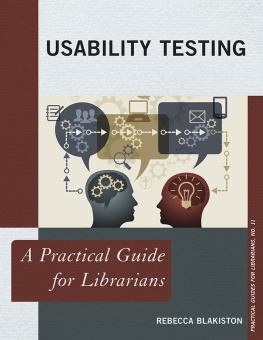
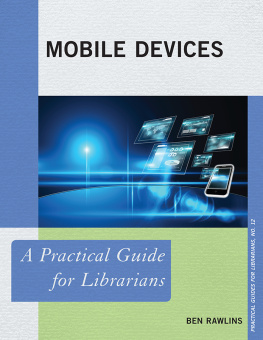

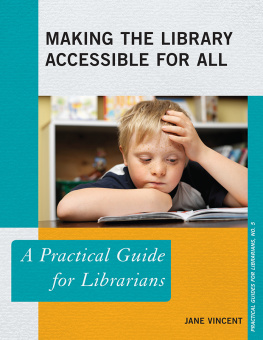

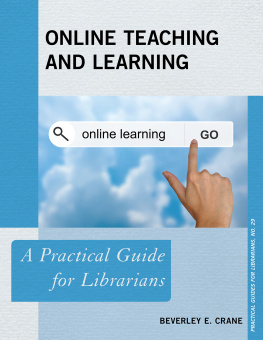
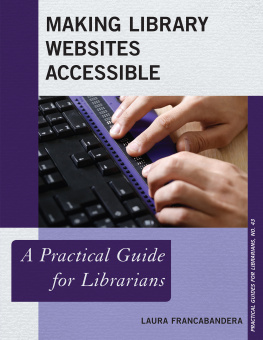
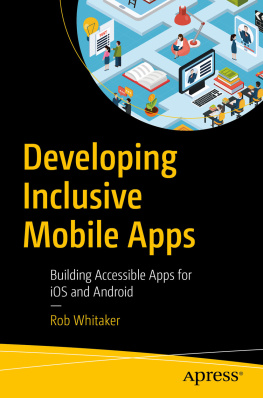
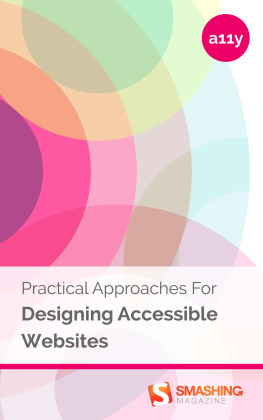



 Definitions
Definitions